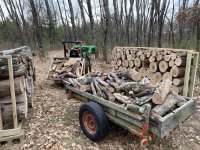Wow, lots of great info and advice and I really appreciate it!
Equipment...
I do have a good chainsaw. For years I had used my Dad's old Poulan and was finally fed up with it and bought a new Stihl last summer. I've learned to sharpen it a lot better over the past year freehand, but the Stihl 2 in 1 easy file makes it a breeze. I still like to be able to do it well free hand though.
I figured a grapple would make light work of some things but I have considered just adding a thumb to the backhoe first before going all out for the grapple. I hadn't considered just dragging logs to a landing to cut to length or trailer home. That would be a good option.
My brother in law has a splitter that I could borrow if needed to get started, but I would prefer to eventually have my own.
I know a guy that does furnace and AC work that I could have set up an indoor wood stove or outdoor furnace if it had to be done 'professionally'. I was leaning towards an indoor woodstove mainly because of price, but I would have to check on insurance issues and it does concern me a little with the flu stack and so on. I wouldn't mind the outdoor furnace. I am constantly taking my dog out in the same area that I would place one, and the firewood, so that wouldn't bother me any. I'm used to it. It is more of an investment but may be worth it in the long run.
My basement is not finished at all, and no insulation on the walls. Just sealed and painted block wall and concrete floor. Not finished, but kept clean. It is all open floor with a man door, and a 7 x 9 utility door on one end. Can't call it a garage door or section off a garage area without getting into insurance issues due the house being overhead. We have a double wide on the foundation. It has the typical insulation on the under side, which is basically the ceiling for the basement. Even a kerosene or wall mount gas heater keeps the basement at around 60° on the coldest nights and it definitely keeps the house level furnace from running quite a bit. My oil heat tank is in the basement also,, which im sure any wood stove would have to be x feet away from it for safety and insurance reasons. Again,, maybe the outdoor furnace would be the better option. I've never looked in to insulation for the walls but that makes sense to be the best place to start to aid with any additional heat source.
The woods... it is on a mountain side. There are a few relatively level areas but 80% of it is not flat. The only good thing would be it is all downhill to get back to the truck. Easy dragging, hauling etc. I could access the majority of it with the tractor pretty safely though, other than a few really rocky spots. I'm glad several folks brought up the fact of dead fallen trees being important to replenishing the soil and homes for critters, hadn't thought of that. Obviously a lot of the already downed trees wouldn't be good for firewood, they've been down too long. But if I would start snagging some as they fall, especially the ones fall over trails, and using them for free firewood rather than go to waste. I don’t think all the more I would use or need would impact the woods too much. And that is the plan, to utilize this wood rather than just toss it to the side. Also glad that folks mentioned about the time frame for firewood to dry. It sounds like if I started anything this winter or spring it may be good for next winter.
You folks have given me a ton of info and advice to consider already and I'm very grateful. This is yet another thing that I can put my little tractor to work with. Any seat time on the tractor is time well spent. I'm anxious to learn more about my options and it looks like there is a wealth of experience and info to go over here. I'll probably contact the heating and AC guy that I know and get some specs and have him evaluate my specific situation before diving into anything. Glad I finally have some direction though.








